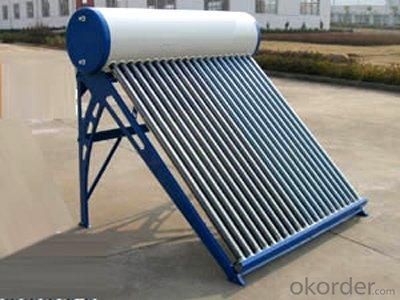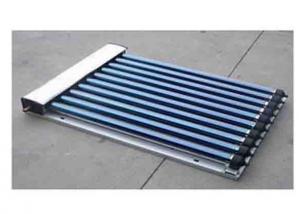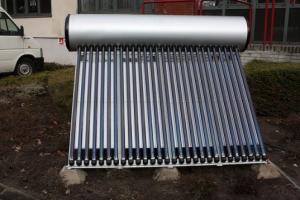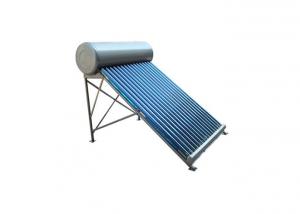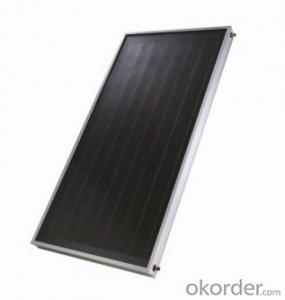12 Tubes Concentrating Solar Collectors En12975
- Loading Port:
- China main port
- Payment Terms:
- TT OR LC
- Min Order Qty:
- 5 set
- Supply Capability:
- 10000 set/month
OKorder Service Pledge
OKorder Financial Service
You Might Also Like
Specification
manifold (inner) | red copper |
manifold (exterior) | aluminum alloy |
glass tube dimensions | 58mm * 1800mm |
daily efficiency | ≥55% |
heat preservation | 72 hours |
hail resistance | 25mm |
max pressure | 7 bar |
coating of vacuum tube | ALN/AIN-SS/CU |
heat pipe | anti-freezing > -35 degree |
certificate | Solar Keymark, EN12975,SRCC |
Serious Product
Models | L*W*H mm | Vacuum tube | Power output | Efficiency | Header mm | Frame | container loading 20FT/40HQ sets | Gross Weight kg |
SHC-8 | 1917*910*133 | 58*1800*8pcs | 939W | 0.668 | Φ35/1.0 | AL alloy | 185/445 | 27 |
SHC-10 | 1917*1130*133 | 58*1800*10pcs | 1189W | 159/385 | 33 | |||
SHC-12 | 1917*1350*133 | 58*1800*12pcs | 1440W | 149/358 | 40 | |||
SHC-15 | 1917*1680*133 | 58*1800*15pcs | 1815W | 120/290 | 49 | |||
SHC-18 | 1917*2010*133 | 58*1800*18pcs | 2191W | 100/242 | 59 | |||
SHC-20 | 1917*2230*133 | 58*1800*20pcs | 2442W | 87/210 | 66 | |||
SHC-22 | 1917*2450*133 | 58*1800*22pcs | 2692W | 83/202 | 72 | |||
SHC-24 | 1917*2670*133 | 58*1800*24pcs | 2943W | 77/188 | 79 |
Packaging & Delivery
Packaging Details: | Exporting Carton with big foaming protection |
Delivery Detail: | In 10-15 days |
Loading Quantity
Model | Tube | Tube Q.T.Y | Loading Q.T.Y/40HQ |
GSC15 | 58*1800mm | 15pcs | 315sets |
GSC18 | 58*1800mm | 18pcs | 265sets |
GSC20 | 58*1800mm | 20pcs | 248sets |
GSC22 | 58*1800mm | 22pcs | 225sets |
GSC25 | 58*1800mm | 25pcs | 200sets |
GSC30 | 58*1800mm | 30pcs | 168sets |
Details of solar collector:

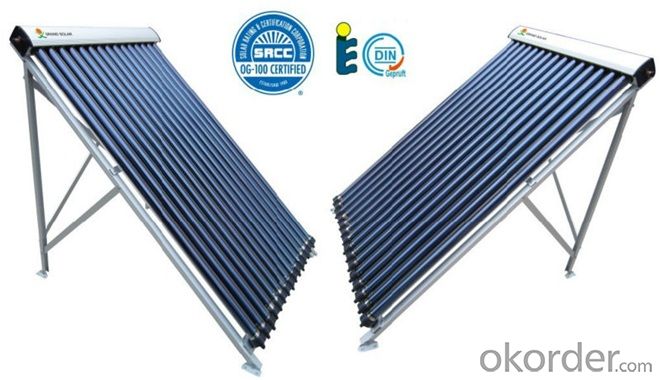


- Q: Can solar collectors be used for heating nursing homes?
- Yes, solar collectors can be used for heating nursing homes. Solar thermal collectors can effectively capture the sun's energy and convert it into heat, which can be used for space heating and hot water systems in nursing homes. This renewable energy source can help reduce heating costs and decrease greenhouse gas emissions, making it an environmentally friendly option for heating nursing homes.
- Q: How do solar collectors compare to other renewable energy sources in terms of cost?
- Solar panels, or solar collectors as they are commonly referred to, are widely recognized as one of the most economically viable sources of renewable energy available today. Although the upfront cost of installing solar panels may be higher than alternative renewable energy options like wind turbines or hydropower plants, the long-term advantages and cost savings they offer make them extremely competitive. Advancements in technology, increased production, and economies of scale have significantly reduced the cost of solar collectors over the years. Consequently, solar energy has become more affordable and accessible for residential and commercial applications. Furthermore, ongoing research and development efforts are expected to further decrease the prices of solar panels while enhancing their efficiency and effectiveness. One key advantage of solar collectors is their low-maintenance nature and long lifespan, typically lasting for 25-30 years or more. This means that once installed, the operational costs associated with solar panels are relatively minimal. In comparison, other renewable energy sources, such as wind turbines or hydropower plants, may require more frequent maintenance and incur higher operational costs. Moreover, solar energy is abundant and universally available, making it a feasible option in various regions across the globe. Unlike some other renewable energy sources like geothermal or tidal energy, solar energy can be harnessed nearly anywhere, given access to sunlight. This widespread availability further contributes to the cost-effectiveness of solar collectors. In conclusion, solar collectors offer a highly competitive cost advantage compared to alternative renewable energy sources. Despite the initial installation cost being relatively higher, the long-term benefits, decreasing prices, low maintenance requirements, and universal availability make solar energy a cost-effective and sustainable choice for fulfilling our energy needs.
- Q: How do solar collectors affect noise pollution?
- Solar collectors do not contribute to noise pollution as they do not produce any noise during their operation. Unlike traditional energy sources such as fossil fuel power plants or wind turbines, solar collectors do not require any moving parts to generate electricity. This means that there are no mechanical components like turbines or engines to create noise. As a result, solar collectors have no impact on noise pollution and are considered to be a silent and environmentally-friendly energy solution.
- Q: Can solar collectors be used for heating tennis courts?
- Yes, solar collectors can be used for heating tennis courts. Solar collectors, such as solar thermal panels or solar air heaters, can capture solar energy and convert it into heat. This heat can then be used to warm up tennis courts, providing a more comfortable playing environment.
- Q: How do solar collectors perform in areas with high humidity?
- Solar collectors can still perform effectively in areas with high humidity. However, excessive moisture in the air can slightly reduce their efficiency by causing some condensation on the surface of the collectors. Regular maintenance and cleaning can help mitigate any negative impact and ensure optimal performance in such conditions.
- Q: Can solar collectors be used to generate electricity?
- Yes, solar collectors can be used to generate electricity through the process of converting sunlight into usable electrical energy using photovoltaic cells.
- Q: Can solar collectors be used for heating swimming pools in winter?
- Yes, solar collectors can be used for heating swimming pools in winter. However, the efficiency of solar collectors can be affected by weather conditions and the angle of the sun during winter months. It is important to have a properly designed and sized solar heating system to ensure optimal performance during colder seasons. Additionally, using a pool cover can help retain heat and reduce heat loss, making solar collectors more effective for winter pool heating.
- Q: Are solar collectors suitable for agricultural greenhouses?
- Yes, solar collectors are suitable for agricultural greenhouses. They can provide a cost-effective and sustainable source of energy for heating, cooling, and lighting in greenhouses, thereby reducing dependency on traditional energy sources. Solar collectors can help create a more environmentally friendly and energy-efficient environment for growing crops in agricultural greenhouses.
- Q: Can solar collectors be used in cloudy weather?
- Yes, solar collectors can still be used in cloudy weather. While the efficiency may be reduced, they can still generate electricity or heat by capturing diffuse sunlight.
- Q: Can solar collectors be used for generating electricity on tablets?
- Solar collectors, also referred to as solar panels, cannot be utilized directly on tablets to generate electricity. The purpose of solar collectors is to convert sunlight into usable electrical energy. Nonetheless, tablets lack the essential infrastructure to support solar panels and convert the generated electricity into a viable form. Tablets typically depend on rechargeable batteries or power cords to fulfill their energy requirements. Although portable solar chargers exist, capable of generating electricity to charge tablets, they are not integrated into the tablet's design.
Send your message to us
12 Tubes Concentrating Solar Collectors En12975
- Loading Port:
- China main port
- Payment Terms:
- TT OR LC
- Min Order Qty:
- 5 set
- Supply Capability:
- 10000 set/month
OKorder Service Pledge
OKorder Financial Service
Similar products
Hot products
Hot Searches
Related keywords








